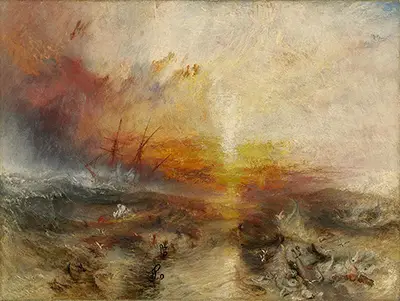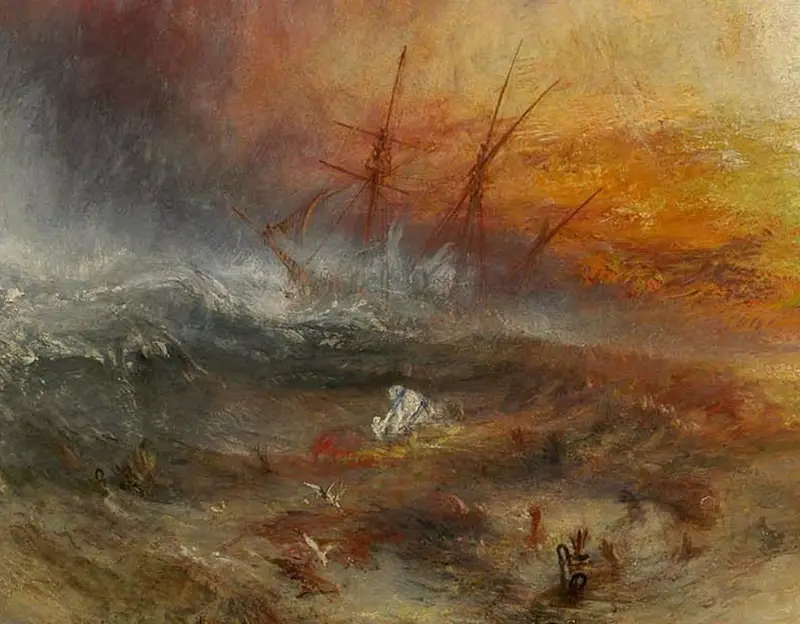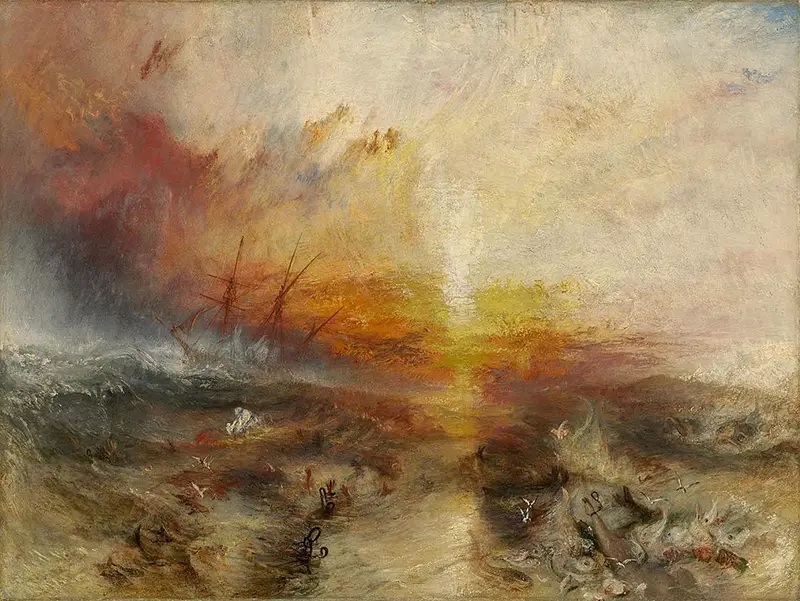 Buy Art Prints Now
Buy Art Prints Nowfrom Amazon
* As an Amazon Associate, and partner with Google Adsense and Ezoic, I earn from qualifying purchases.
This painting was initially known as Slavers Throwing overboard the Dead and Dying - Typhoon coming on. It was completed by William Turner in 1840 and is currently in the Museum of Fine Arts, Boston.
The inspiration behind this painting was a book published, by the title The History of Abolition of Slave Trade. The book, written by Thomas Clarkson, tells of an event that happened in 1783. It included a ship that harboured slaves. The so called captain of that ship was being compensated by an insurance company. But the insurance covered for the slaves that were lost at sea, not the apparent sick ones that died on board. In order to get full compensation, the captain ordered all the sick slaves jump off the ship. It is at this point that we can fully relate to the former title. Turner was greatly moved by the cruel events that took place on that ship and he decided to lay it all out in waves of emotions.
In this painting, Turner does not use a well-defined paint brush. Instead, his strokes appear blurry and less specific, such that the viewer is prompted to use his/her imagination. This is a Turner signature, a typical Romantic art. Like any other painter, he focuses or rather hints at one particular aspect. Here the aspect of nature is clearly brought out by the distinct ocean and sky strokes, it doesn't matter that the painting is about the ship. He used a variety of colour shades on the painting, but at the first glance, one can easily notice that dark red/maroon is more conspicuous than any other.
Perhaps to emphasize the bodies of the deceased slaves. After that, comes the red, yellow and orange colours, all mashed up to imitate a beautiful sunset. The general use of colour gives a warm and sombre scene, all too vivid. The ocean, being a major aspect, is portrayed fiercely with huge and daring waves. It looks tired from carrying the burden of all those dead slaves, daring as it is, it still comes across as helpless. According to Turner's view, we can assume, he felt that the ship was somewhat like a curse to humans and all their wrong doings. It was meant to be an act of punishment. With all that to swallow, we still have to acknowledge that in the background, it all seems peaceful, as nature should be.
This harrowing content proved extremely controversial at the time, with many being entirely uncomfortable with the cruelty of man being laid quite so bare by the artist in this painting. The truth hurts, as they say. It is actually hard to imagine such behaviour in today's world, even with all the problems that we currently have. It is a stark reminder of what can happen when people are denied their liberty and basic freedom, something that we often all take for granted in the developed world in the present day. It is artworks such as this that underline how Turner was not just a painter of light, but also had a message to communicate through his work. His bullish character would have meant he'd ignore most of the criticism that came his way upon the unveiling of this painting - he felt strongly that there was a higher purpose to be served.
"...Aloft all hands, strike the top-masts and belay;
From the artist's poem, Fallacies of Hope (displayed next to the piece at the Royal Academy)
Yon angry setting sun and fierce-edged clouds
Declare the Typhon's coming.
Before it sweeps your decks, throw overboard
The dead and dying – ne'er heed their chains
Hope, Hope, fallacious Hope!
Where is thy market now?..."
An interesting footnote to this painting is that Slave Ship may actually have had a companion piece in the form of Rockets and Blue Lights. The latter offers a more humane image of society, meaning these two offer a stark contrast when placed together. They may have have been what we term 'pendant' paintings. Both scenes were completed in 1840, though Rockets and Blue Lights has not survived the years since particularly well and has required major renovation work on a number of occasions. Many of the original brushstrokes are no-longer there. The content is one of the artist's many works on the theme of maritime safety and warning systems, where lives are attempted to be saved, as opposed to lost as found in Slave Ship.
Turner was hoping that by shining a light on the horrors of slavery, through this painting, that pressure would begin to build on the ruling powers around the world. His desire was for all countries to cease in the use of slavery, rather than just some which was the case at that point. There was a growing momentum behind a collection of individuals, loosely placed under the banner of Abolitionists. JMW Turner can be placed in that category due to the content and intentions of this piece. Famous artists for many centuries have often been inspired by the various horrors of the world, and many have used this medium in order to campaign for a more just society. Anti-war artworks are particularly common, of course, as are those more subtlely aimed at improving the treatment of minorities within western society, be it women or ethnic groups. The most famous example would be Picasso's Guernica, which objected to the rule of Franco.
There can be no doubt as to the shock factor inherent in this painting. John Ruskin, a famous art critic within the UK, was gifted this painting by his father. He could not cope with the subject matter for long, though, and decided to sell it on soon afterwards. For someone who adored the career of Turner, this would have been a difficult decision to make, and clearly underlines just how deeply the theme of this painting cut across society. Indeed, the feelings would have been particularly raw at that time, with many countries still insisting on the use of slavery as a legitimate part of society. With a modern eye we can still understand the anger and discomfort with the images of hands reaching out from the waves as the slaves drowned, but without quite the same level of guilt as would have, and should have, been felt at that time. With a smaller national media at that time, which was also not accessible to as wide a section of society, paintings such as this were also even more important in shaping attitudes within the public than they are today. There is a cropped image of the painting at the bottom of the page which draws your attention to the various hands which appear from the sea in desperation.
JMW Turner remains one of the most famous and influential artists of all time and many believe him to have been the finest British artist in history. He took inspiration from the earliest landscape painters such as Giorgione and Claude, though this was a movement which was still in its infancy at that stage. William added some extraordinary use of light as well as a British slant, with exciting seascapes and also some charming views of British countryside and historic architecture. It was these developments which were to later inspire several members of the Impressionist movement in France, which itself is considered one of the most important movements in European art history. We know very well how much the likes of Monet would study the achievements of Turner and use it to find a new way forward through their own collection of artists in Paris. Whilst they added huge amounts of their own imagination and technical craft, the original inspiration was undoubtably important.
Naturally, as well as being a landscape and seascape painter, Turner was also considered a Romanticist painter. The involved a connection to the inner soul that previously had not been given such a significant focus. Accuracy of form was more important before this, as well as the concentration on other types of content, such as religion and mythology. The likes of Turner and Constable would lay the groundwork for those who followed, with landscape painting now being considered a legitimate art form for the first time. Previously, those artists who liked to make use of it in their work would normally have to include other elements in the foreground in order to ensure that it was still considered a part of an 'acceptable' genre. Thankfully, modern tastes are much more varied and there is room for a much greater variety of tastes today. Turner's style can be said to be a perfect balance between the old and new - technically supreme, with a strong handle of colour, whilst the forms are delivered from both the eye and the heart. It is hard to come up with a better example of this in practice than with the Slavers Throwing overboard the Dead and Dying - Typhoon coming on painting that you find here.
This is an artist whose mark is deeply felt within the UK. It is rare for a year to go by without an exhibition of his work somewhere in the country, with curators becoming more and more creative about how to present the exceptional oeuvre that he left behind. Focus can be offered exclusively to his drawing or watercolours, for example, or perhaps on an individual location in which he worked, such as Venice or London. The sheer number of pieces from his career that remain under the ownership of British art institutions has ensured that these exhibitions are fairly easy to organise, as opposed to other artists whose work maybe spread all across the world, within a variety of private collectors and public institutions. In the present day, an artist who is famous and whose paintings are easily accessible, will remain in the public's eye without fail.






